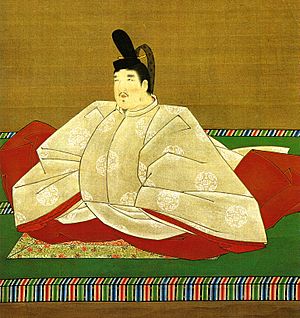Emperor Go-Murakami facts for kids
Quick facts for kids Emperor Go-Murakami後村上天皇 |
|||||
|---|---|---|---|---|---|
 |
|||||
| Emperor of Japan | |||||
| Reign | September 18, 1339 – March 29, 1368 | ||||
| Coronation | November 6, 1339 | ||||
| Predecessor | Go-Daigo | ||||
| Successor | Chōkei | ||||
| Shōgun | Ashikaga Takauji Ashikaga Yoshiakira |
||||
| Born | 1328 | ||||
| Died | March 29, 1368 (aged 39–40) | ||||
| Burial | Hinoo no Misasagi (檜尾陵) (Osaka) | ||||
| Issue more... |
Emperor Chōkei Emperor Go-Kameyama |
||||
|
|||||
| House | Yamato | ||||
| Father | Emperor Go-Daigo | ||||
| Mother | Fujiwara no Renshi | ||||
| Signature | |||||
Emperor Go-Murakami (後村上天皇, Go-Murakami-tennō) (born 1328, died March 29, 1368) was the 97th emperor of Japan. He was part of the Southern Court during a time when Japan had two rival imperial courts. This period is known as the Nanboku-chō period.
He ruled from September 18, 1339, until his death on March 29, 1368. His personal name was Noriyoshi. Emperor Go-Murakami often had to move his court. He ruled from places like Sumiyoshi in Osaka, Yoshino, and Nara.
This emperor from the 14th century was named after Emperor Murakami from the 10th century. The word go- means "later" or "second." So, he is sometimes called "Later Emperor Murakami" or "Murakami II."
Contents
Life and Reign of Emperor Go-Murakami
Early Life and Challenges
Prince Norinaga, who would become Emperor Go-Murakami, was the son of Emperor Go-Daigo. His mother was Lady Renshi. He grew up during a very difficult time in Japan. Two groups were fighting over who should be the true emperor. These groups were called the Northern Court and the Southern Court. This conflict is known as the Nanboku-chō period.
In 1333, when he was very young, Prince Norinaga went to Tagajō (in what is now Miyagi Prefecture). He went with Kitabatake Akiie to try and get the eastern samurai to support his father, Emperor Go-Daigo. They also worked to defeat the last parts of the Hōjō clan.
Battles and Movements
In 1336, Ashikaga Takauji started a rebellion. Prince Norinaga and Kitabatake Akiie returned to Sakamoto to fight him. But Takauji defeated them in Kyōto. They had to go back to Mutsu Province.
In 1337, Tagajō was attacked, so they moved west again. They fought many battles as they traveled back to Yoshino. In 1338, Prince Norinaga tried to go to Tagajō again but had to return to Yoshino because of a storm.
Becoming Emperor
In October 1338, Prince Norinaga was named Crown Prince. On September 19, 1339, he became emperor after his father, Emperor Go-Daigo, passed away. Kitabatake Chikafusa became his main advisor.
In 1348, Kō no Moronao attacked Yoshino, where the Southern Court was located. The Emperor had to leave and move to a new temporary location.
In 1352, Emperor Go-Murakami entered Otokoyama. His general, Kusunoki Masanori, managed to take Kyōto back from Ashikaga Yoshiakira. During this time, in April 1352, three former Northern Emperors were captured and taken to Anau, where the Southern Court was. However, within 20 days, Ashikaga Yoshiakira recaptured Kyōto.
The Emperor and his group were trapped in Otokoyama. But they managed to escape to Kawachi Province during another attack by Yoshiakira. A few months later, they returned to Yoshino.
Later Reign and Decline
In 1361, Hosokawa Kiyōji and Kusunoki Masanori, who had rejoined the Southern Court, attacked Kyōto. They took control of it for a short time. But Yoshiakira quickly fought back, and they had to leave Kyōto in less than 20 days.
The Southern Court kept trying to take back Kyōto, but their power was getting weaker. By the time Emperor Go-Murakami died in 1368, Ashikaga Yoshimitsu was in charge of the Northern Court. The Southern Court's base had moved to Sumiyoshi.
Emperor Go-Murakami's tomb is called Hinoo no misasagi. It is located near the Kanshin-ji temple in Kawachinagano, Osaka.
Japanese Era Names During His Reign
In Japan, years are also counted using special names called nengō. These names change when a new emperor takes the throne or for other important events. During Emperor Go-Murakami's reign, there were different era names used by the two rival courts.
Southern Court Eras
These are the eras recognized by the Southern Court:
Northern Court Eras
These are the eras recognized by the Northern Court:
- Ryakuō (1338–1342)
- Kōei (1342–1345)
- Jōwa (1345–1350)
- Kannō (1350–1352)
- Bunna (1352–1356)
- Embun (1356–1361)
- Kōan (1361–1362)
- Jōji (1362–1368)
- Ōan (1368–1375)
Family of Emperor Go-Murakami
Emperor Go-Murakami was the seventh son of Emperor Go-Daigo.
- Consort: Minamoto (Kitabatake) Akiko, daughter of Kitabatake Chikafusa
- First daughter: Imperial Princess Noriko (1345-1391)
- Court Lady: Fujiwara no Shōshi, daughter of Ano Sanetama
- First son: Imperial Prince Yutanari, later Emperor Chōkei
- Second son: Imperial Prince Hironari, later Emperor Go-Kameyama
- Fourth son: Imperial Prince Yasunari (1360–1423)
- Consort: Okurakyo-no-Tsubone
- Third son: Imperial Prince Korenari (died 1423)
- Fifth son: Imperial Prince Moronari (1361–1431)
- Consort: Reizen-no-Tsubone
- Seventh son: Imperial Prince Yoshinari (died 1395)
- Other children (mother unknown):
- Sixth son: Imperial Prince Kanenari
- Daughter: Imperial Princess Sadako
See also
 In Spanish: Go-Murakami Tennō para niños
In Spanish: Go-Murakami Tennō para niños
- Imperial cult
- List of Emperors of Japan


